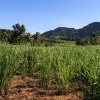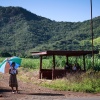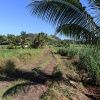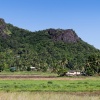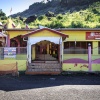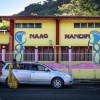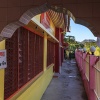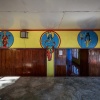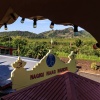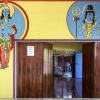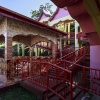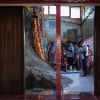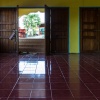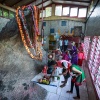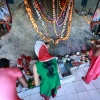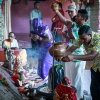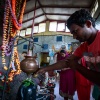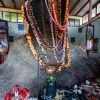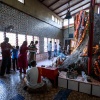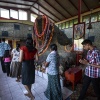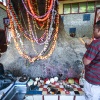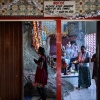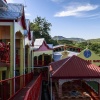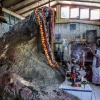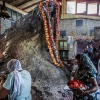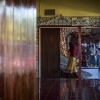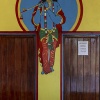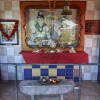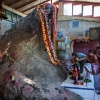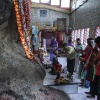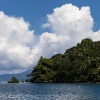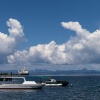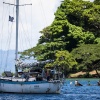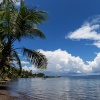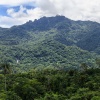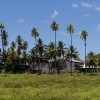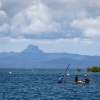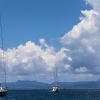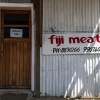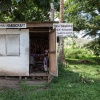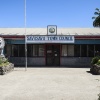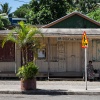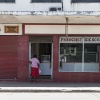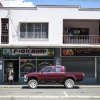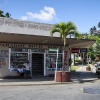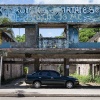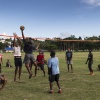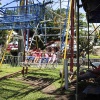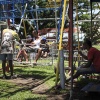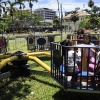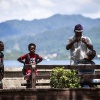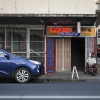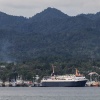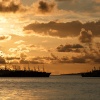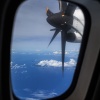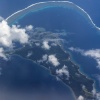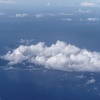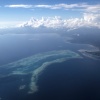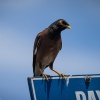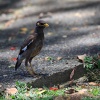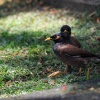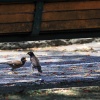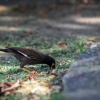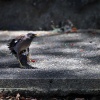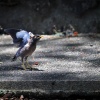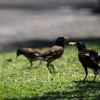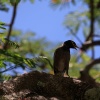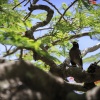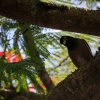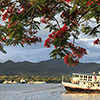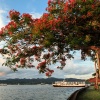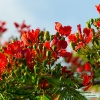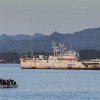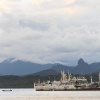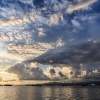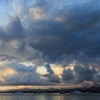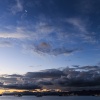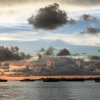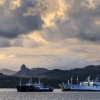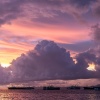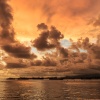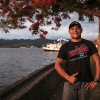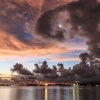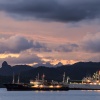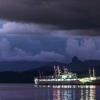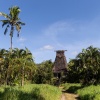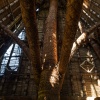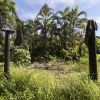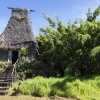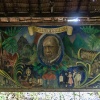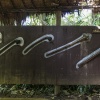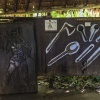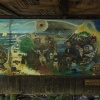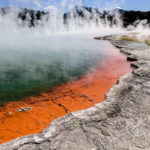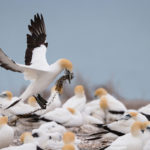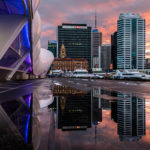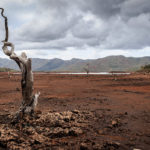Fiji – Melting Pot of the South Seas
In the Realm of the Cobra
Yes, Fiji is ruled by the military, but as traveller you don’t notice much of that. 1987 is a year of destiny for Fiji as since then the army is in charge since the economically strong Indians won the elections, which is something that didn’t please the actual land owners, the Melanesians, a lot. From a western point of view this military coup might have described using attributes like “nationalist” or even “racist”, but that doesn’t meet the Melanesian temper at all. Actually it’s the opposite as everywhere people smile, everybody greets and approaches travellers with joy. That this culture maintained itself and did not surrender to the Indians is something being not all too bad.
The second largest island of the Fiji archipelago gives an insight how strong the Indian influence can be as on Vanua Levu the sugar cane industry, the actual reason why Indian people are on Fiji, becomes optically evident even for travellers. Having reached the airport of Labasa I quickly notice that there won’t happen much bus-wise, hence I need a taxi and take their drivers to a negotiation task for a daytrip as the places I want to see are not within a 20 minute distance. Of course an Indian won the bid; a guy first bringing me to his home to show the German around in his family. After having survived this, including a mandatory goodbye tongue kiss from a granny – actually his wife, however it was gross (!!!) either way – he drove me to the mountains near Labasa as initially arranged.
Those hills are where Naag Mandir, the Snake Temple or also called Temple of the Growing Stone can be found. Its retina tickling yellow painted houses, not less involving pink and blue, are the final destination for all Hindu pilgrims around. The temple premises are built around a giant boulder that for the Hindus appears in the shape of an attacking cobra. Snakes play an important role in Hinduism. Main God Shiva has a snake around his neck and God Vishnu even sleeps on a five-headed variant of this reptile. Golden Temple, Rat Temple and the Taj Mahal – on my journey through North India I have witnessed plenty of religious things, but meeting a pilgrimage site being more Indian than India in the Pacific is flabbergasting par excellence.
Before entering the temple shoes have to be taken off. The interior of the actual temple is quite compact, however there is enough space to sacrifice offerings like milk, coconuts and flowers before the believers start orbiting the stone with folded hands and mumbling their prayers. Every time they reach their starting point the priest rings a bell, which doesn’t keep him away from his second job, that is constantly scenting the air with incense so heavy making your eyes tear. Believers repeat their walk around the stone a couple of times before going on a 108 steps long outer stairs up to the shrine of Gods Shiva and Parvati to have another couple of prayers. Witnessing all that is so funky; I feel like being teleported onto the subcontinent, somewhere between Calcutta and Mumbai.
Indians are not fussy when it comes to driving and also my Indian driver brings me to the places I want to see much quicker than I prefer. Our next stop is Savusavu, a little city at the south coast of Vanua Levu having a similar natural harbour like Suva hence it’s pretty much patronised by sailors travelling the South Seas sailing-wise. From there I could even go on a ferry back to Suva, but a cyclone warning for Eastern Fiji forces the ferry to stay in the harbour. Hence the ATR of Pacific Sun, a turboprop plane, is in charge of bringing me back to Nausori, the airport near Suva.
On this Sunday temperatures reach 34°C but it’s the air humidity of more than 90% that makes every walk becoming a sticky and humid experience, actually, as even at that weather people enjoy sportivities on the field in front of the governmental building. Over here the locals indulge themselves in cricket, volleyball or rugby. Their joy of playing is exuberant and invites to change roles from spectator to player. However, if you find yourself in a rugby session then better be prepared to take some hits ;-)
I go back to the waterfront where a little funfair fights the heat and makes children hearts leap for joy. All carrousels look steely-archaic and rattle constantly driven by deafening Diesel motor noise, not to mention the wonderful Diesel exhalations. However, the kids have an award-winning smile in their face.
Lots of people let another Indian immigrant appear on the scene and actually it’s the initial contact with India right after having left an aircraft. The speech is about the Common Myna, a cheeky and noisy starling bird originally coming from Asia but spreading out all over the South Pacific, even reaching New Zealand being 3 flight hours away from Fiji and funnily enough not a few NZ tourists confuse the Meina with the Tui, one of New Zealand’s actual heraldic birds. The bird is fun to watch but is one of the biggest pests in the South Pacific as it’s an invasive species, hence a threat for the eco system there.
Meanwhile the sun is about to descend and the reddish light of the evening sun kicks the red of the flame trees up a notch being even more red than red. A wonderful scene. The clouds of the raining season are impressive and our disappearing central star paints them in all colours; it sets the whole heaven on fire. Seemingly driven by the fisher boats’ never ending Diesel motor buzzing the sickle moon starts its journey through the sky towards the horizon to finally disappear behind Joke’s Thumb, a mountain and Fiji’s Sugar Loaf Hill.
Having that mountain in sight, I enjoy several really good evenings in Suva and often good food isn’t far away meaning proper Chinese, Indian or the already mentioned Indo-Fijian cuisine. For example when Taro or Dalo get involved, both are a potato consistency-alike root plant. When they get crumbed with Indian spices and get served with fresh fish, then things start to become literally awesome!
Being located not far away from picturesque Joske‘s Thumb, the artificial town of Pacific Harbour, being made for tourists only, invites the same audience to spend their money. I always turn my back on such artificial things, also because not far there’s something much more interesting, a real cannibal site. The man-eater premises are somewhere hidden in the jungle, even the big pointy-roofed main house isn’t noticeable at first glance.
Once that building was richly adorned with the skulls of the people the cannibal enjoyed to eat, more than 90 skulls. The place where he indulged himself in human meat until the late 1980’s is quite eerie, on the other hand the place is now a little museum and definitely worth to be seen as it’s way much more authentic and educational than the touristic display in the neighbour town.
On the way back from Suva to Pacific Harbour I see lots of plantations atypically growing western vegetables instead of Taro or Dalo and I realise, that Viti Levu has many plantations looking like that. My driver Anil calls them “Part of the New Middle Kingdom”, because China subsidises other countries by building important infrastructure and civil institutions, like for example a new hospital or roads, and since that is not for free, China gets the right to fish in Fiji’s sea plus gets the right to grow vegetables for the home market. The farmers are local Fijians but then grown goes straight for export. “That is the price we have to pay. They are allowed to make extensive use of our land and may loot our fishing grounds.” continues Anil.
